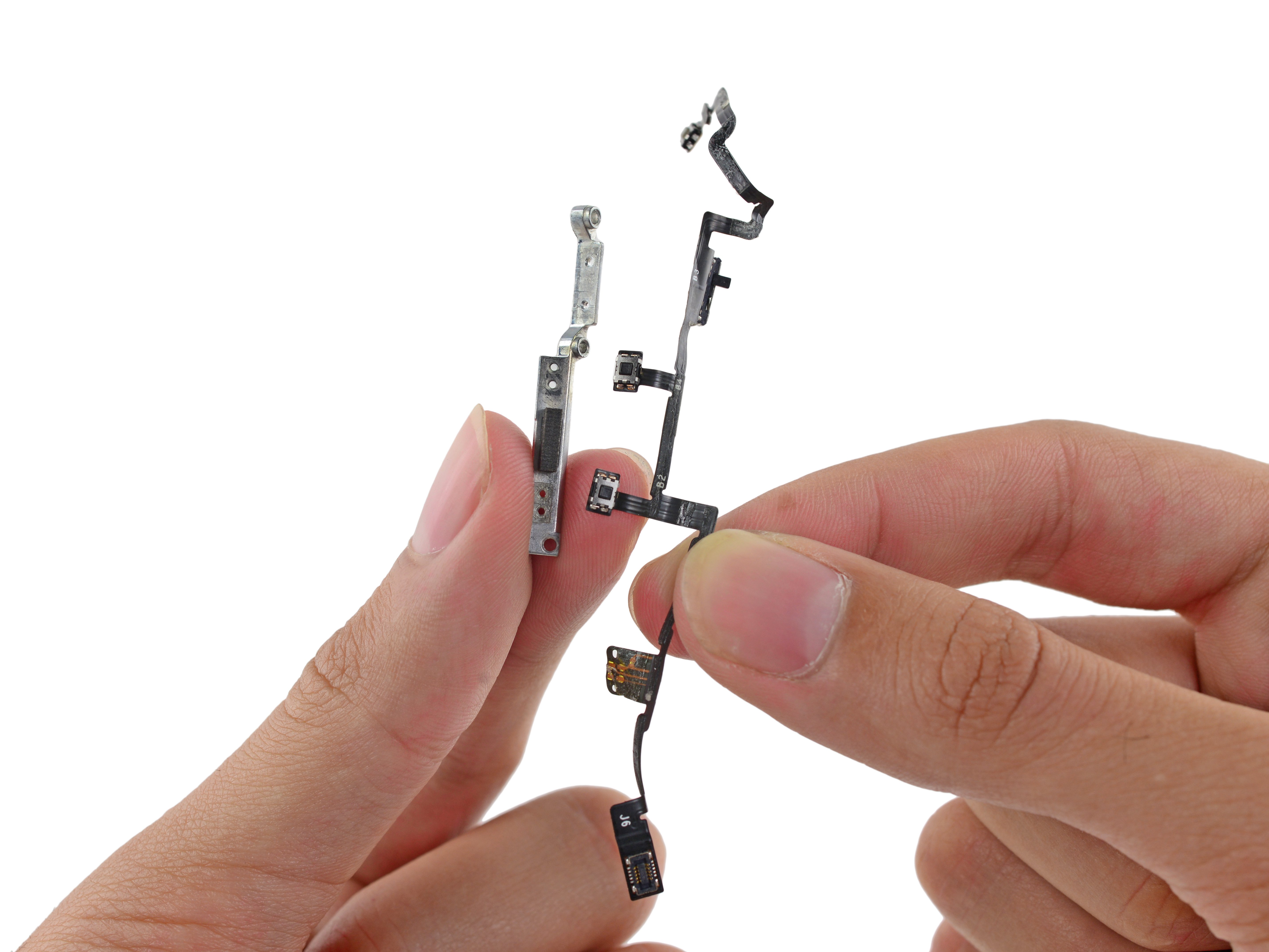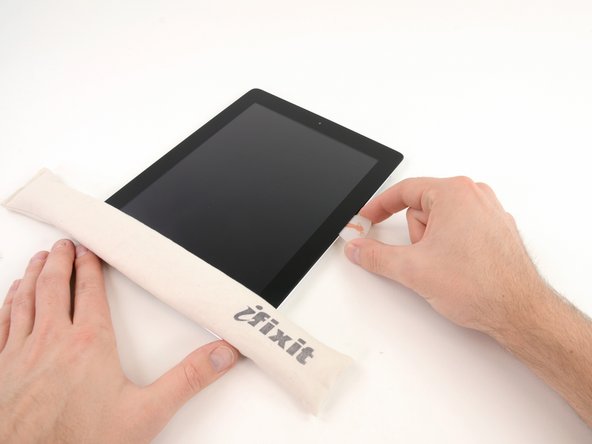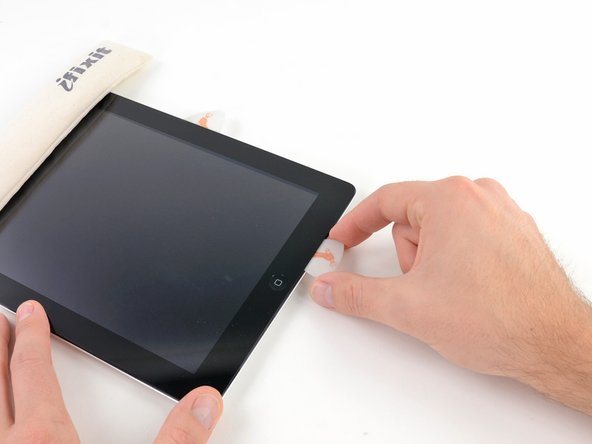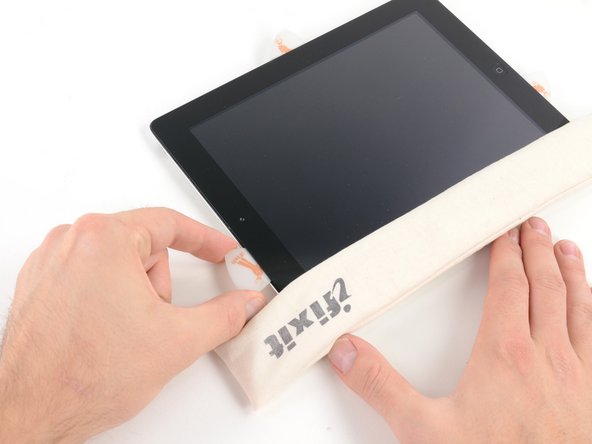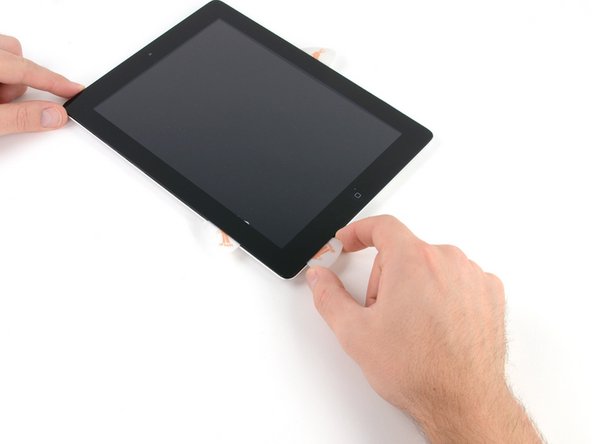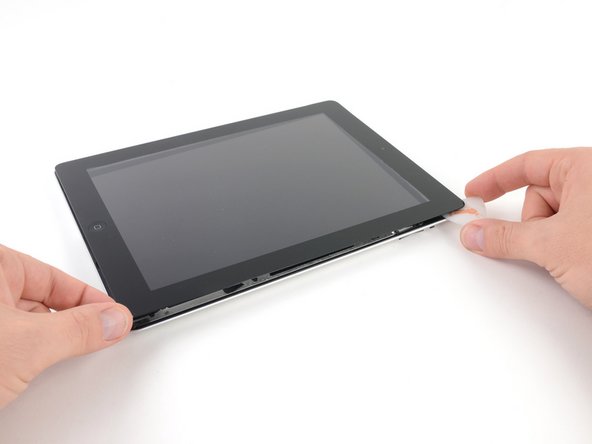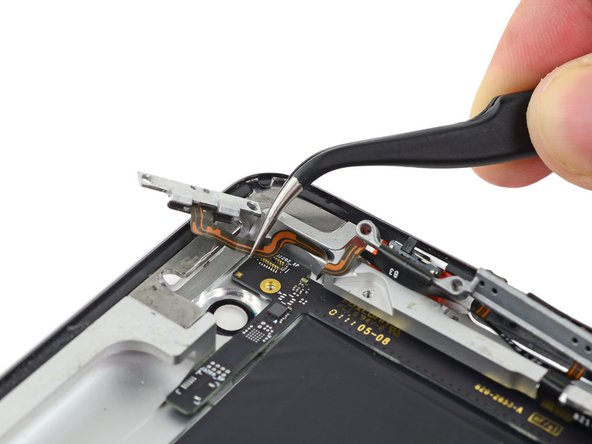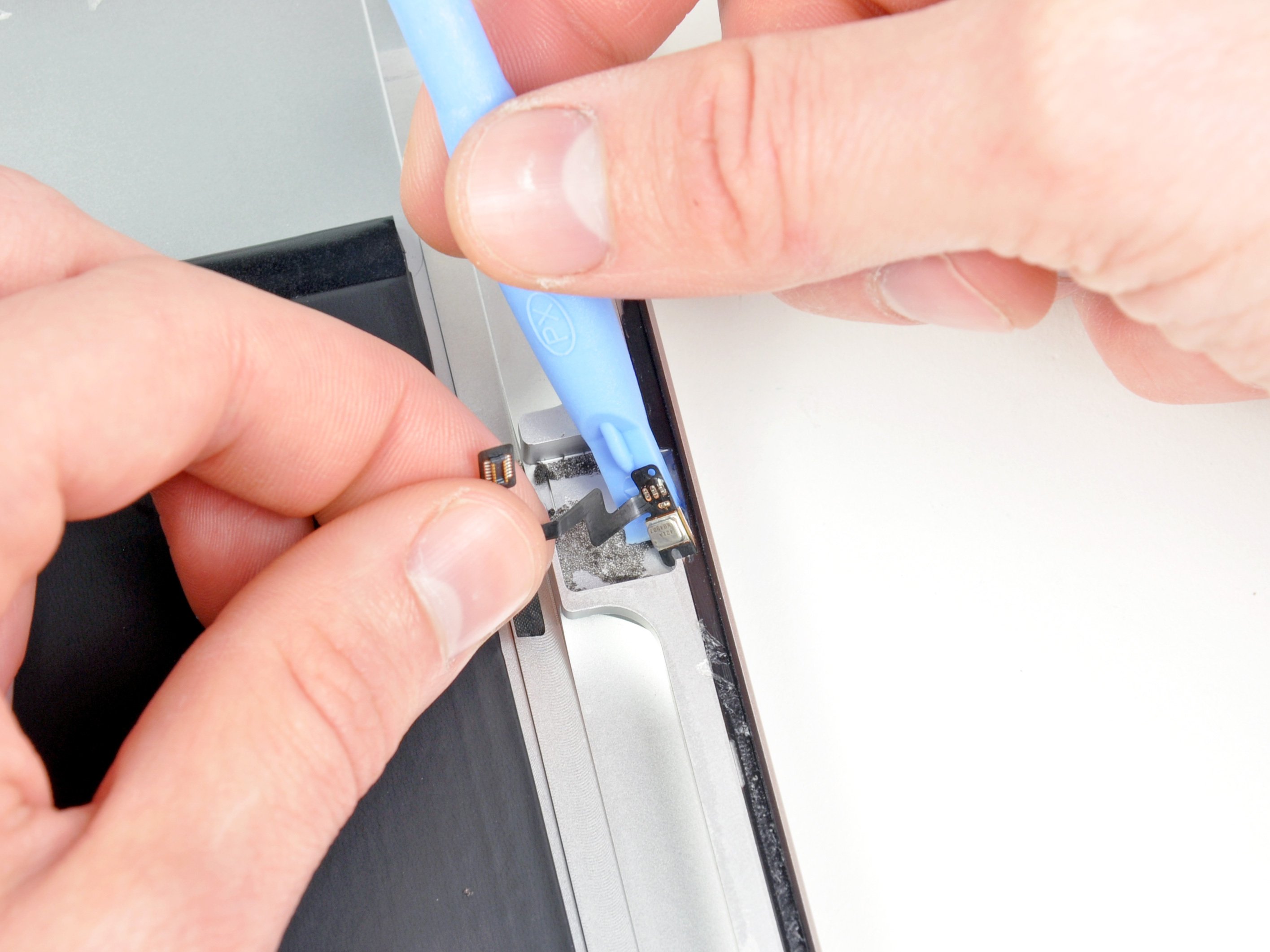iPad 2 Wi-Fi EMC 2415 Volume and Power Button Cable Replacement
Duration: 45 minutes
Steps: 58 Steps
Ready to give your iPad 2 Wi-Fi EMC 2415 a little TLC? This guide walks you through swapping out the volume and power button cable assembly, which also happens to include the sensor for your Smart Cover magnet. It's a smooth, easy fix that’ll have your iPad feeling as good as new. If you hit a snag along the way, don’t stress – just schedule a repair and we’ll take care of it.
Step 1
For carousel microwaves: Double-check that the plate spins smoothly without any hiccups. If your iOpener gets stuck, it can heat up too much and cause burns—so keep it moving!
It's a good idea to give your microwave a quick clean before you dive in. Trust us, any stubborn gunk left behind might just hitch a ride on the iOpener.
- Pop that iOpener right in the middle of the microwave!
Tools Used
Step 2
Keep an eye on your iOpener—overheating it might cause it to pop like a balloon. Don't crank the heat past 100˚C (212˚F).
If your iOpener looks puffed up or swollen, hands off! It's time to pause.
If the center of the iOpener is still too toasty to touch, keep it on while it cools down a bit before warming it up again. When heated right, it should stay pleasantly warm for around 10 minutes.
Microwave wattage varies, so adjust the heating time accordingly. Your iOpener is ready when it’s just a tad too warm to keep your fingers on comfortably.
- Pop the iOpener in the microwave for 30 seconds to get it warmed up and ready for action.
- As you go through the repair steps, keep an eye on the iOpener—it’ll cool down, so give it a quick 30-second reheat whenever you need it.
Tools Used
Step 3
Heads up! The iOpener gets super hot, so handle with care. If you need to, grab an oven mitt to keep those fingers safe.
- Carefully take the iOpener out of the microwave, gripping it by one of the flat ends to keep your fingers safe from the hot middle part.
Tools Used
Step 4
Heads up! The iOpener gets seriously hot, so make sure to grab it only by the end tabs to keep your fingers safe.
No microwave? No problem! Just heat your iOpener by placing it in some boiling water instead.
- Grab a pot or pan and fill it with enough water to completely immerse the iOpener.
- Bring the water to a boil, then turn off the heat. No need to overdo it!
- Pop the iOpener into the hot water for about 2-3 minutes. Just make sure it’s fully submerged in the water.
- Using tongs, carefully pull the iOpener out of the water. It's hot, so be cautious!
- Give the iOpener a good drying with a towel. Make it nice and dry!
- All set! Your iOpener is now ready to roll. If you need to reheat it later, simply bring the water back to a boil, turn off the heat, and let the iOpener soak for 2-3 minutes again.
Tools Used
Step 5
Pop on those safety glasses to keep your eyes safe, and remember—handle that LCD screen with care. You’ve got this!
This will keep those pesky glass shards from going rogue and help maintain the strength of your display while you work your magic prying and lifting it.
- If your display glass is cracked, keep the shards in check and protect yourself by taping over the glass before you dive in.
- Carefully place overlapping strips of clear packing tape all across the iPad's screen until it’s fully covered.
- Follow the rest of the steps as outlined, but heads up—once the glass is cracked, it might keep spreading while you work. You may need to use a metal prying tool to carefully scoop out the broken glass.
Step 6
Heads up! Since you might be handling some broken glass here, we highly suggest rocking a pair of safety glasses to keep those sneaky shards from making a surprise appearance in your eyes.
- Place the iOpener flat along the right edge of the iPad, making sure it hugs the surface nicely for maximum heat transfer.
- Chill out for about 90 seconds while the heat does its magic before you try popping open that front panel.
Tools Used
Step 7
Getting the plastic opening tool between the glass and plastic might need a little muscle. Take your time, be patient, and gently wiggle the tool back and forth until it slides in. No rush here – just a steady hand and a little persistence!
- There's a small gap in the iPad's adhesive ring, just a couple of inches down from the top-right corner (around 5 cm). This is your opening—literally!
- Line up your tool with the mute button and carefully insert the very tip of a plastic opening tool into the gap between the front glass and the plastic bezel. Just a little nudge to widen the crack is all you need.
Step 8
- Position the tool carefully between the plastic bezel and the front glass panel. It's like a little puzzle piece—make sure it fits just right.
Step 9
- Gently wedge the tip of your plastic opening tool between the front glass and plastic bezel, then slide a plastic opening pick into the gap right next to it to carefully separate the pieces.
Step 10
- Gently pull the plastic opening tool away from the iPad, and then slide the opening pick just a bit deeper under the front glass, about half an inch or so. Take your time here, it’s all about finesse!
Step 11
- As you tackle the task of loosening the adhesive on the right side of the iPad, give the iOpener a quick reheating session, then pop it back on the bottom edge of the iPad. You've got this!
Tools Used
Step 12
This adhesive is seriously stubborn—get ready to flex those muscles, but keep it cool and take your time!
If you spot the tip of the opening pick sneaking out from under the front glass, gently pull it back just a bit. Using the pick this deep won’t cause any harm, but it might leave some sticky adhesive marks on the LCD.
- While the iOpener is warming up the bottom edge, start loosening the adhesive along the right side of your iPad.
- Gently slide the opening pick down the edge, peeling away the adhesive as you go.
Tools Used
Step 13
You might need to slide the heated iOpener back onto the right edge of the iPad as you work through releasing the adhesive. How long the iPad has had to cool down while you’re at it will determine if this move is needed.
- If your opening pick gets stuck in the adhesive, try 'rolling' it gently along the edge of the iPad to keep loosening that sticky stuff.
Tools Used
Step 14
- Before popping that first opening pick out from the bottom corner of your iPad, slip a second pick underneath the right edge of the front glass. This will help keep that sticky adhesive from making a comeback!
- Give your iOpener a quick reheat, then slide it up to the top edge of the iPad. You're almost there!
Tools Used
Step 15
The Wi-Fi antenna is screwed and connected by a cable on the bottom right edge of the iPad's rear case. Since the antenna’s orientation is a bit particular, take your time and handle it gently to avoid any permanent mishaps.
- Okay, heads up! The next steps call for some serious care and attention.
- You’ll need to carefully loosen the adhesive holding the antenna to the front panel without messing up the delicate connectors linking the antenna to the bottom of the iPad. Take it slow and follow along closely.
Step 16
Keep the pick from sliding past the bottom right corner—going further might mess up the Wi-Fi antenna, and we don’t want that!
- Gently slide the opening pick around the bottom right corner of the iPad to loosen the adhesive holding it in place.
Step 17
Carefully slide the opening pick along the bottom right edge of the front panel. Watch out for the Wi-Fi antenna near the corner—it’s super close and can get cut if the adhesive comes loose the wrong way.
Just a little tip—literally! Keep that pick snugly under the front glass, but don’t pull it all the way out. Let about 1/8" (3 mm) of the tip stay tucked in there for now. You've got this!
- Gently glide the opening pick along the bottom edge of your iPad, freeing up the adhesive that's holding down the Wi-Fi antenna. You're doing great—keep it steady!
Step 18
- Alright, let’s get moving! Once you’ve navigated past the Wi-Fi antenna—about 3 inches (75 mm) from the right edge, or just a hop away from the home button—slide that opening pick back in all the way.
- Now, give that pick a gentle slide to the right to break free the adhesive holding the Wi-Fi antenna to the front glass.
- Remember, the antenna is snugly attached to the bottom of the iPad with screws and a cable. By doing this step, you're safely detaching the antenna from the front panel, making sure it stays safe and sound when you lift the panel off.
Step 19
Keep the iOpener heating sessions to under a minute, and remember to chill it out for at least two minutes before giving it another warm-up!
If the adhesive has cooled too much on the bottom edge, just give the iOpener a quick reheat to warm things up again where you’re working. It’ll help everything stick nice and easy!
- Keep sliding the opening pick along the bottom edge of the iPad, carefully pulling it out just enough to loop around the home button, then slide it back in about half an inch (10 mm) once you've passed that button.
Tools Used
Step 20
When working on iPad 4 models, slide the pick in no deeper than 1/2 inch (10 mm) here to keep that home button ribbon cable safe and sound.
- Keep on peeling back that adhesive along the bottom edge of your iPad like a pro!
- Slide that opening pick snugly under the front glass close to the home button and let it hang out there.
Step 21
- Pop the iOpener back in the microwave to warm it up, then place it on the left edge of the iPad to gently soften the adhesive in that area.
Tools Used
Step 22
If the adhesive has gotten too cool, just pop the iOpener back along the top edge and keep going. And if the iOpener itself has cooled off too much, give it a quick reheat to bring it back to life.
- Gently glide the opening pick along the top edge of your iPad, giving it a little pull to navigate around the front-facing camera bracket.
- Be prepared, because the adhesive in this area is pretty stubborn! Take your time and apply some muscle, but be careful not to slip and hurt yourself or your iPad.
- If the opening pick feels like it's getting caught in the adhesive, try 'rolling' it as shown in step 9.
Tools Used
Step 23
If the adhesive is feeling warm enough, go ahead and take that iOpener off the iPad for a bit of easy maneuvering. But if it's still holding on tight, just give the iOpener another heat-up and place it on the left edge while you tackle the task at hand.
- Keep peeling back the adhesive along the top edge of the iPad, and carefully slide your opening pick around that top left corner like a pro.
Tools Used
Step 24
Heads up! The digitizer cable hangs out about 2" (50 mm) from the bottom edge of your iPad. When sliding your pick, ease off around 2.25" (60 mm) from the bottom to keep things safe and sound.
- Gently glide the opening pick down the left side of your iPad, peeling away that sticky adhesive as you go. It’s a little less clingy here thanks to the digitizer stretching along that entire left edge, so take it easy! Keep the pick shallow—no deeper than half an inch (about 10 mm)—to keep your digitizer happy and intact.
Step 25
Heads up! The bottom of the digitizer cable is just about an inch (25 mm) from the iPad’s bottom edge. Take it slow and steady—don’t let that cable get snipped!
- With the opening pick still tucked under the bottom edge of the iPad, gently work it to free the adhesive at the bottom left corner.
Step 26
It looks like some of that sticky adhesive around the edge of your iPad might have decided to play hide-and-seek again! No worries, just slide a pick under the edge where the front glass is still hanging on and gently 'cut' through that adhesive to free it up. You've got this!
- Grab one of those handy opening picks and gently lift up the bottom right corner of your iPad. Use your fingers to hold it steady as you work your magic!
Step 27
Watch out for any sticky stuff that might still be clinging on! Grab an opening pick and gently slice through any adhesive that’s busy holding the front panel in place.
- Grip the iPad by the top and bottom right corners, then gently swivel the front glass away from the device.
- When putting it back together, grab a microfiber cloth and some compressed air to wipe away any dust or smudges from the LCD before snapping the glass back on.
Step 28
- Take out those four 2.0 mm Phillips screws that are holding the LCD to the rear case. You've got this!
Step 29
Handle the LCD with care, and remember: it's not going anywhere! Just gently rotate it over without trying to detach it from the iPad—its display data cable is still hanging on for the ride.
To get to those sneaky front panel ribbon cables hiding beneath the LCD, you'll need to give the LCD a little flip and set it aside for a moment. Easy peasy!
- Grab the LCD by the long edge closest to the volume buttons and carefully flip it out of the rear case—kind of like turning a page in a book.
- Place the LCD face down on the front panel to keep it safe and sound.
Step 30
- Gently peel away the rubber cover from the metal camera retainer and take it off the iPad 2.
Step 31
Make sure that little thermal pad is cozy with the metal retaining clip, just like in the third picture, when you’re swapping out that rear-facing camera!
- First up, take out these two screws:
- Carefully pop the metal retainer clip straight up out of its cozy spot in the rear panel.
- One 3.3 mm Phillips screw
- One 2.1 mm Phillips screw
Step 32
- Gently use a plastic opening tool to lift the rear camera connector out of its socket on the control board.
- Carefully take out the rear-facing camera.
Step 33
- Take out these screws from the volume/power button assembly cable:
- Two 2.5 mm Phillips #000 screws, angled at 45º, holding down the power button.
- Two 5 mm Phillips #000 screws.
- One 2 mm Phillips #000 screw, also at a 45º angle.
Step 34
- Take off the metal bracket holding down the rotation lock and silent switch—time to set those parts free!
Step 35
- Gently pull the power button cable out from its cozy little spot in the rear case and give it a little bend to keep it out of the way.
- Now, check out that ribbon cable! It’s carrying the mechanical button that needs to connect with the plastic button cover still hanging out in the case.
Step 36
- Let's start by gently prying the sleep/power button out from the back case. Be careful, we don't want any unnecessary drama!
- Pay close attention to how everything is oriented for when it's time to put things back together. Remember, the metal spring bar should be facing downward, towards the back of the case. You've got this!
Step 37
Keep the bracket in place since it’s still hanging out with the button ribbon cable.
- Grab the center screw hole on the volume control bracket, give it a little tilt toward the edge of the case, then lift it right out of its cozy spot.
Step 38
- Carefully lift the power button section of the cable away from the back case.
Step 39
- Carefully lift the cable connecting the power button and volume rocker away from the rear case, like you’re gently waking it up.
Step 40
- Gently fold the cable inward toward the back case, but don’t try to yank it out just yet—it’s still hooked up to the upper component board.
Step 41
- First things first, let's get that rotation lock/silent switch off the rear case. It's time to say goodbye to that little guy!
- Make sure to take note of how everything is oriented for when it’s time to put it all back together. That mechanical switch needs to play nice with the button cover, so double-check that they fit together just right!
Step 42
- Gently nudge the volume rocker inward using the tip of a spudger.
- Carefully lift the volume rocker out from the rear case.
Step 43
- Grab your trusty opening pick and gently coax the Smart Cover sleep/wake sensor away from the rear case. Take your time and let it peel away like a banana!
Step 44
- Gently lift the volume rocker part of the button cable off the back case with care.
Step 45
Hey there, just a friendly reminder – don't go yanking that cable out completely! It's still secured by a connector that's taped to the upper component board. Keep it cozy and attached while you work your magic!
- Carefully lift off the last vertical section of the back cover.
Step 46
- Take out the single 2 mm Phillips #000 screw located at the bottom of the upper component board.
Step 47
- Grab a pair of tweezers and gently pull out the foam block wedged between the rear case and the upper component board.
Step 48
Handle that board with care! Give it a gentle touch and avoid bending it too much or letting it rub against the rear case. You’ve got this!
- Slide a spudger gently under the edge of the upper component board and carefully nudge it toward the volume rocker to loosen it from the adhesive.
Step 49
Take extra care to avoid rubbing the board against the top of the rear case. It's a tight squeeze, so keep it cool!
- Slide a spudger carefully under the top left corner of the upper component board and gently lift it away from its sticky adhesive.
Step 50
When you're disconnecting that cable, keep it level—no need to lift it up, just a smooth pull.
- Gently lift the retaining bar holding down the upper component board cable connector.
- Carefully pull the connector straight out from its socket on the logic board.
Step 51
- Gently lift the end of the upper component board cable away from the sticky adhesive that's keeping it snug against the rear case.
Step 52
To take out the upper component board, gently pull on its cable while lifting it just enough to clear the battery. Be careful not to raise it too high and risk scraping the rear case. Take it slow, steady, and easy—patience is key here!
- Gently slide the spudger's tip under the upper component board to give it a little lift.
- Carefully lift the board and slide it out from between the battery and the rear case bezel.
- Now, remove the upper component board from the device.
- When you're putting everything back together, don't forget to reconnect the GPS antenna cable at this stage. Grab some tweezers and go slow—take your time. Also, it’s a good idea to insert the 2 mm Phillips #000 screw from the lower end of the upper component board and thread it in without tightening it yet. Tighten all screws after they’re all in place and threaded properly.
Step 53
- Carefully remove the tape that’s holding down the button cable connector on the upper component board. You're doing great!
Step 54
- Gently lift the button cable connector straight up off its socket on the upper component board, like you're popping off a tiny lid.
Step 55
If your replacement part comes with the metal button brackets already in place, feel free to breeze past the next steps!
- Gently peel the power button off the bracket – a little finesse goes a long way!
- Keep track of how everything lines up and where the adhesive is – it'll make reassembly a breeze.
Step 56
- Gently slide the tip of an opening pick between the rotation lock/silent switch and its bracket to carefully separate the adhesive holding them together.
Step 57
- Gently slide the opening pick under the last bit of the rotation lock/silent switch to lift it up from the button bracket like a pro.
Step 58
- To put your device back together, just go through these steps backward. Easy peasy! And if you hit a snag, you can always schedule a repair with us.
